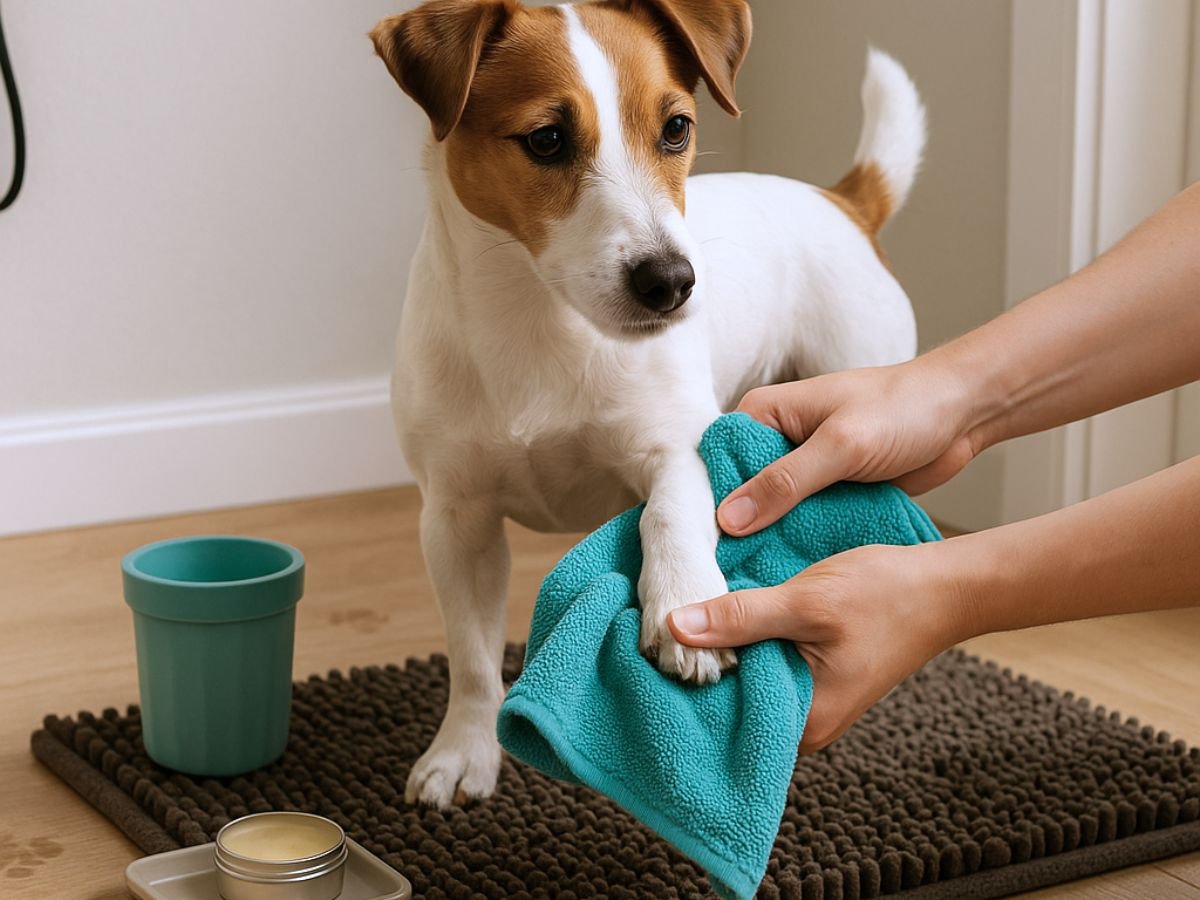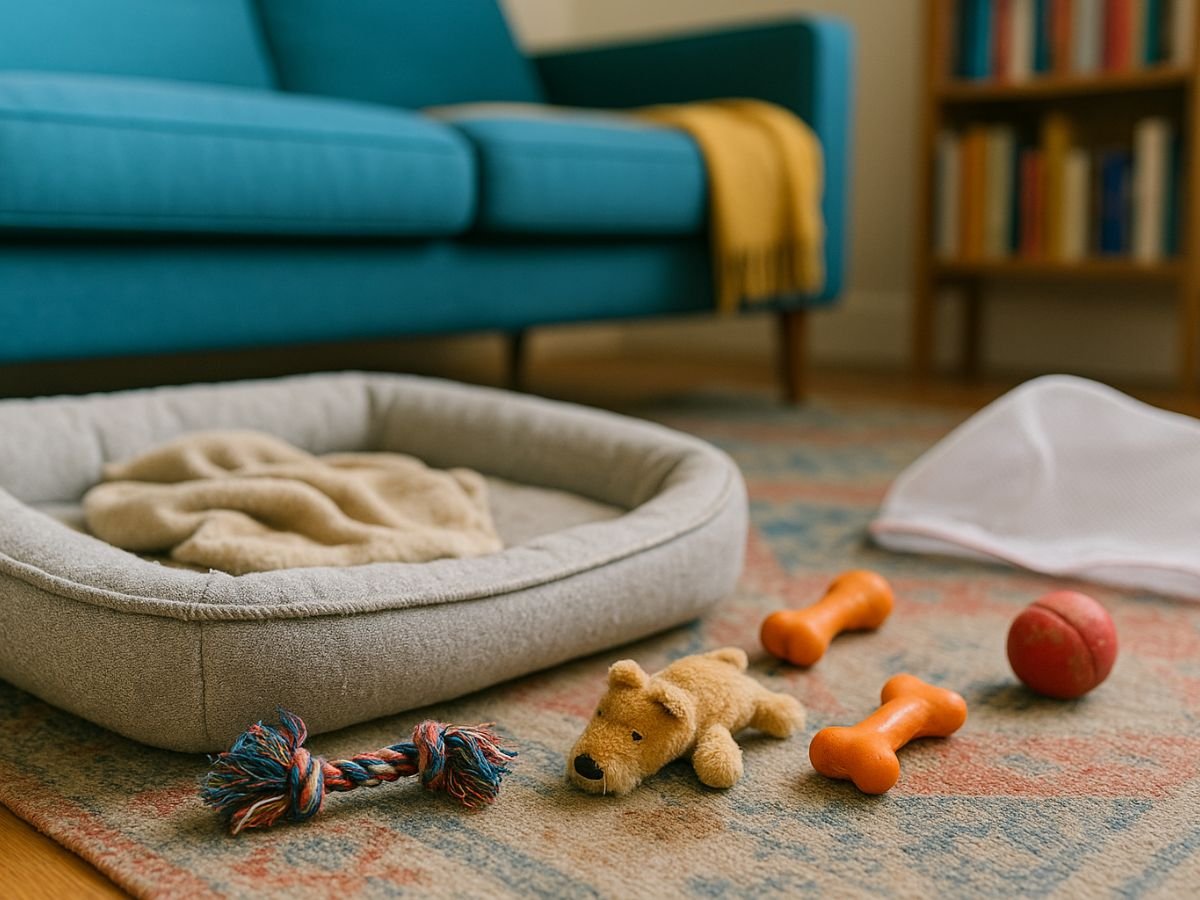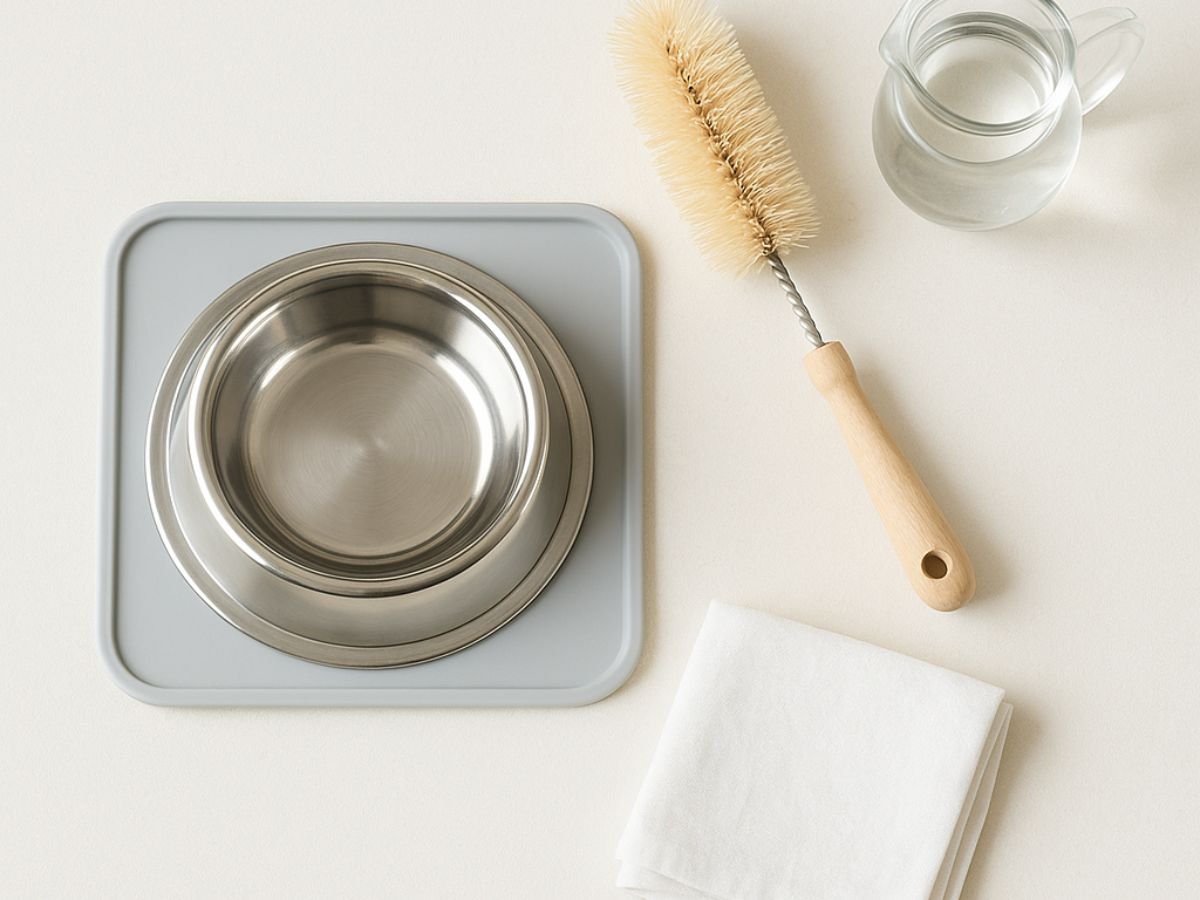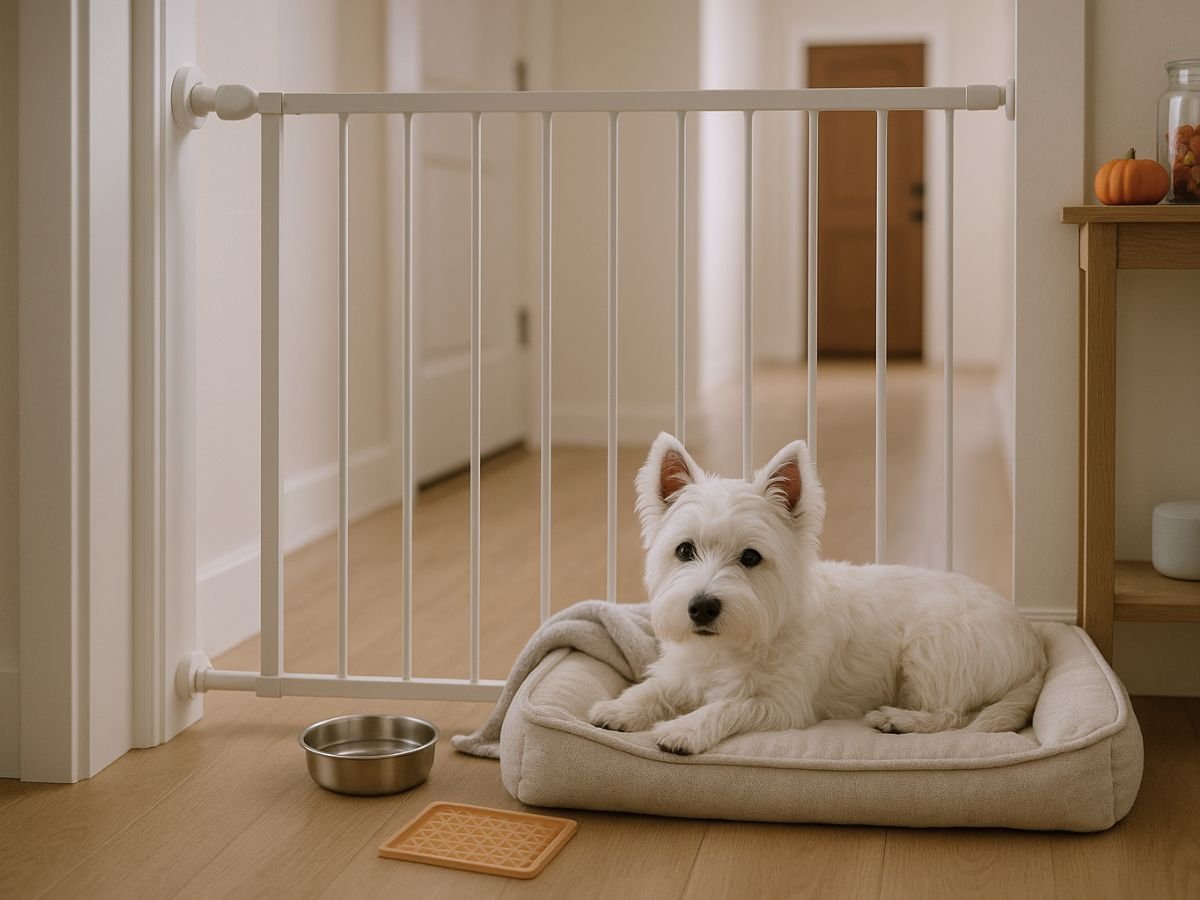Winter Dog Paw Care & Mat Hygiene (Quick Win for Small Dogs)
Cold walks + road salt + slushy parks = itchy paws and a house that smells like a wet gym bag.
Been there—winter dog paw care gets tricky fast. Monty once turned his bed into a mud bowl after a snow day..
This 10‑minute routine protects paw pads, cuts licking, and keeps entry mats fresh.
Plus quick cleans keep outdoor bacteria, lawn chemicals, and fecal residue off your floors and sofa—and out of your dog’s mouth when they lick their paws.
Less dirt inside, fewer tummy upsets and skin flare‑ups.
Key Takeaway: If you only do one thing today, wipe and fully dry between the toes after every winter walk—then rotate a clean mat.
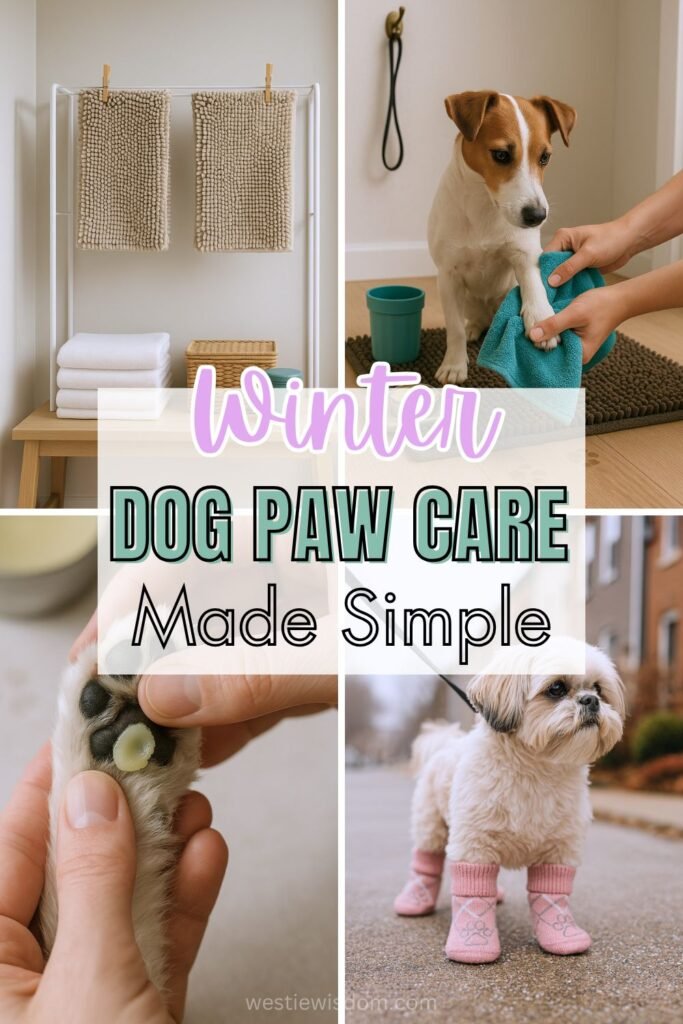
Quick Win (do it now)
- Wipe + Rinse Paws: Use lukewarm water or a damp cloth; remove salt/grit (prevents dryness & licking).
- Dry Between Toes: Pat dry thoroughly—moisture trapped between pads leads to irritation.
- Rotate Mats: Swap to a dry mat; toss the wet one in the wash basket. (Takes ~10 minutes. Perfect for flats & small dogs.)
Mini‑Guide
1) Set up a winter entryway station
Place a high‑absorbency chenille doormat, a small tub of lukewarm water, soft cloths/microfiber towels, and a bin for dirty mats near the door before going off to walkies.
Keep a squeezable paw cleaner cup handy for muddy days.
Pro tip: I keep Monty’s “landing strip” ready: mat → towel → balm. It trims our post‑walk chaos to under 3 minutes.
2) Clean & Dry (every walk)
Dip each paw in the cup or wipe with a damp cloth. Focus on the spaces between pads and around the nails to remove salt, grit, and de‑icers. Avoid hot water or harsh soaps—lukewarm water is enough for daily cleans.
Pat dry with a clean towel, then do a quick finger check between each toe. For fluffy paws, a 10–15‑second cool‑settingblast from a hair dryer at a safe distance can help—no heat.
Safety notes: avoid using human hand sanitisers or strong household soaps on paws; if you do use a dryer, keep it on cool and at least 20 cm (8 in) from the skin.
Pet‑safe de‑icers: If your area uses ice melt, pet‑safe products are preferable to rock salt, but you should still rinse and dry paws after walks. See AVMA winter safety and Pet Poison Helpline for details.
For heavy mud days, a quick swish in a sink or tub sometimes is easier—see our Dog Bathing Stations: 25+ Genius Ideas for Laundry Rooms, Garages & More for set‑ups that make rinses mess‑free.
Small‑dog tweak: Lift your pup on a bench/chair with a towel for better reach and less wriggle.
Budget‑aware option: Repurpose clean cotton T‑shirts or tea towels as paw towels; they wash/dry fast.
3) Protect pads & calm licking (as needed)
Massage a thin layer of dog paw balm into pads before walks (barrier), and again after drying on harsher days (soothing).
If licking ramps up, swap routes away from heavily salted paths and do an extra rinse.
Pro tip: A pea‑sized amount is plenty for small sized dogs (like a Westie)—too much gets slippy on floors.
4) Mat & bedding hygiene (set a simple schedule)
- Entry mats: quick rinse/hot wash 1–2× weekly depending on use.
- Blankets/bed covers: weekly in winter; removable covers make this painless.
- Toy spot‑clean: as needed; machine‑wash soft toys in a lingerie bag monthly.
Small‑dog tweak: Two mats on rotation = always‑dry landing pad for tiny paws.
Copy/Paste Checklist
[ ] Wipe paws with lukewarm water after every walk (salt/grit off).
[ ] Pat dry thoroughly, especially between toes.
[ ] Apply a thin layer of paw balm on harsh days.
[ ] Rotate to a dry entry mat; wet mat into the wash basket.
[ ] Wash entry mats 1–2× weekly (hot cycle if care label allows).
[ ] Weekly check: cracks, redness, or chewed nails → monitor/trim.
[ ] Trim foot fur lightly to reduce ice balls (if applicable).
[ ] Avoid highly salted routes; add a quick rinse on return.
[ ] Keep towels + wipes stocked at the door.
[ ] If persistent licking/redness, call your vet (possible allergies/irritation).
What to Buy
Disclosure: As an Amazon Associate, I earn from qualifying purchases (at no extra cost to you).
- Chenille “no‑slip” doormat — grabs water/grit fast; perfect landing strip for small dogs.
- Paw washer cup — quick salt/grit removal without a full bath.
- Dog paw balm (beeswax‑based) — protects/soothes dry pads; use sparingly.
- Fragrance‑free pet wipes — handy for light messes and quick toe checks.
- Lightweight sock‑style booties — soft, easy‑on protection for salted/icy routes; great for small paws.
Good/Better/Best (budget‑aware)
| Tier | What’s in it | Why it works | Est. budget |
|---|---|---|---|
| Good | Doormat + paw balm + 2 towels | Removes moisture/salt; basic pad protection | <$25 |
| Better | Doormat + paw washer + balm + wipes | Faster, deeper clean on salt days | <$40–$50 |
| Best | Add soft booties + second mat | Shields from salt; always‑dry landing spot | <$65–$80 |
Quick <$25 winter kit: doormat + balm + 2 cotton towels (washable) keeps paws comfortable without overspending.
Clean Paws, Calm House
A tiny routine = comfortable paws and a fresher home.
Monty approves (mostly because it leads to snacks).
Keep the momentum: tidy paws today, fresh bedding tonight, calmer snoozes tomorrow.
Or jump straight to Settle on Mat for an easy evening wind‑down.
FAQs About Winter Dog Paw Care
1. Do small dogs need boots in winter?
Boots help on salted or icy routes by protecting dog paw pads and improving traction. Many small dogs tolerate soft, sock‑style booties; for short, dry walks a thin layer of paw balm may be enough. Try them indoors first for 2–3 minutes so your dog adjusts.
2. What signs of paw irritation need the vet?
Persistent redness or swelling, limping, a strong odor/discharge, bleeding cracks, or constant paw‑chewing that doesn’t settle within 24–48 hours. Also call your vet if you see foreign material lodged between pads or if your dog seems painful.
3. How do I clean dog paws after a winter walk?
Use lukewarm water and a soft cloth or a paw washer cup to remove salt/grit, then pat dry between the toes. Skip harsh soaps for daily use.
4. Are road salt and de‑icers harmful to dogs?
Yes—contact can dry/irritate pads and ingestion during licking can upset tummies. Rinse/wipe paws promptly and consider booties on heavily salted routes. “Pet‑safe” de‑icers (marketed as paw‑friendly) are safer than rock salt, but you should still rinse/dry paws after walks. See AVMA winter pet safety and Pet Poison Helpline on ice melts for details.
5. Why is my dog licking paws more in winter?
Salt, wetness, and cold cause dryness/itch, which triggers licking. Clean, dry thoroughly, and add a light paw balm. If redness or odor persists, ask your vet.
6. What helps dry or cracked dog paw pads?
Gentle daily cleaning, full drying, a thin paw‑balm layer, and route changes help. Severe cracks, bleeding, or limping need veterinary care.
7. Do I need a paw cleaner (paw washer) or are wipes enough?
Wipes are fine for light dirt; a washer cup excels with grit/salt. Many owners keep both: wipe for errands, cup for muddy parks.
8. How often should I wash entry mats and dog bedding in winter?
Entry mats: 1–2× weekly; dog bed covers/blankets: weekly. Rotate a clean/dry mat daily if it gets soaked.
9. Can I use baby wipes on dog paws?
Choose pet‑safe, fragrance‑free wipes. Baby wipes can contain ingredients that irritate some dogs; check with your vet if unsure.

